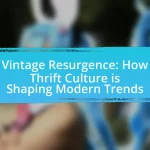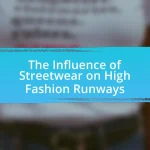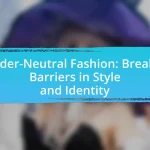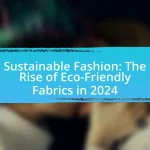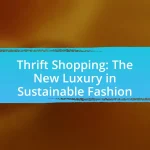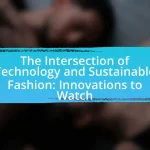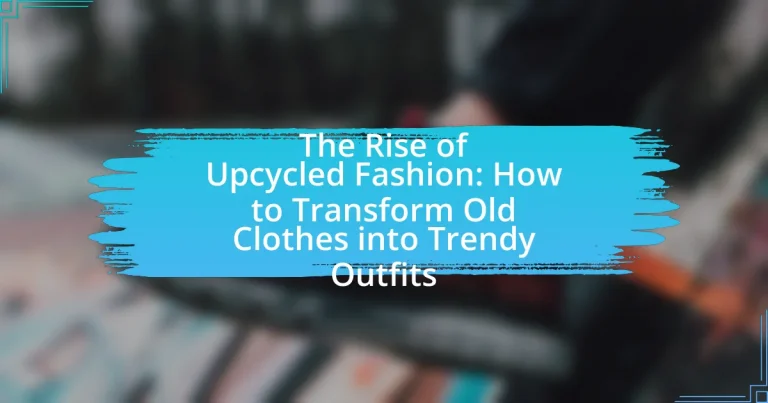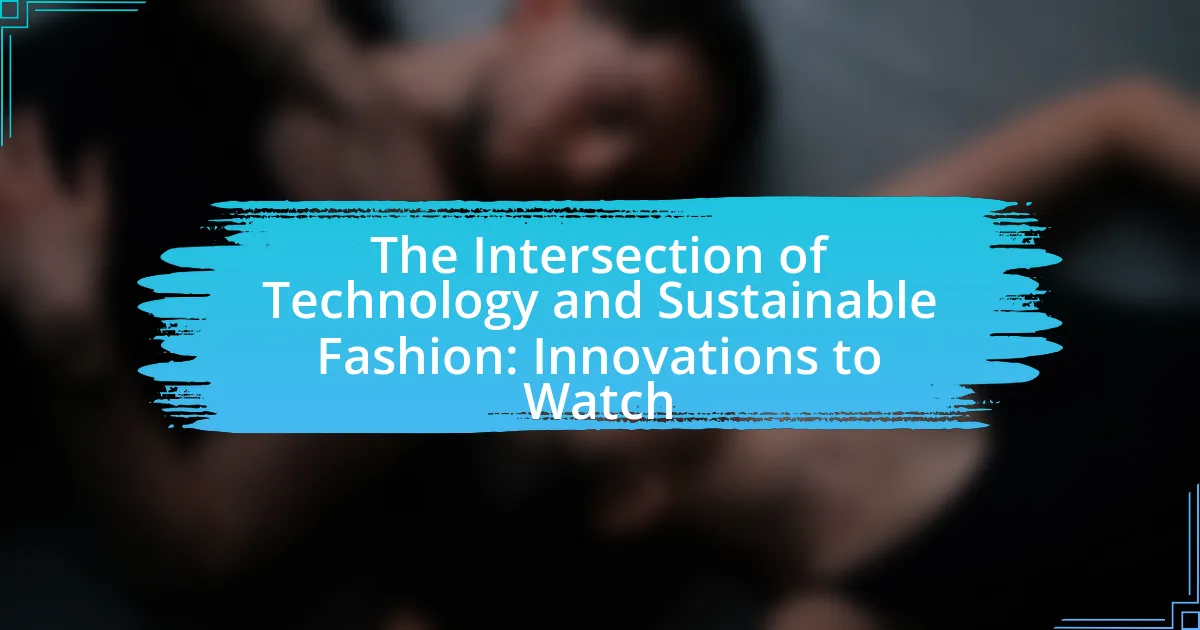Upcycled fashion is the practice of repurposing old or discarded clothing and materials into new, fashionable items, significantly reducing waste and promoting sustainability in the fashion industry. This article explores the differences between upcycled and traditional fashion, highlighting key principles such as sustainability, creativity, and resourcefulness. It discusses the environmental impacts of upcycled fashion, popular trends, and practical techniques for transforming old garments into trendy outfits. Additionally, it provides insights into successful upcycled fashion brands and offers practical tips for beginners looking to engage in upcycling projects.
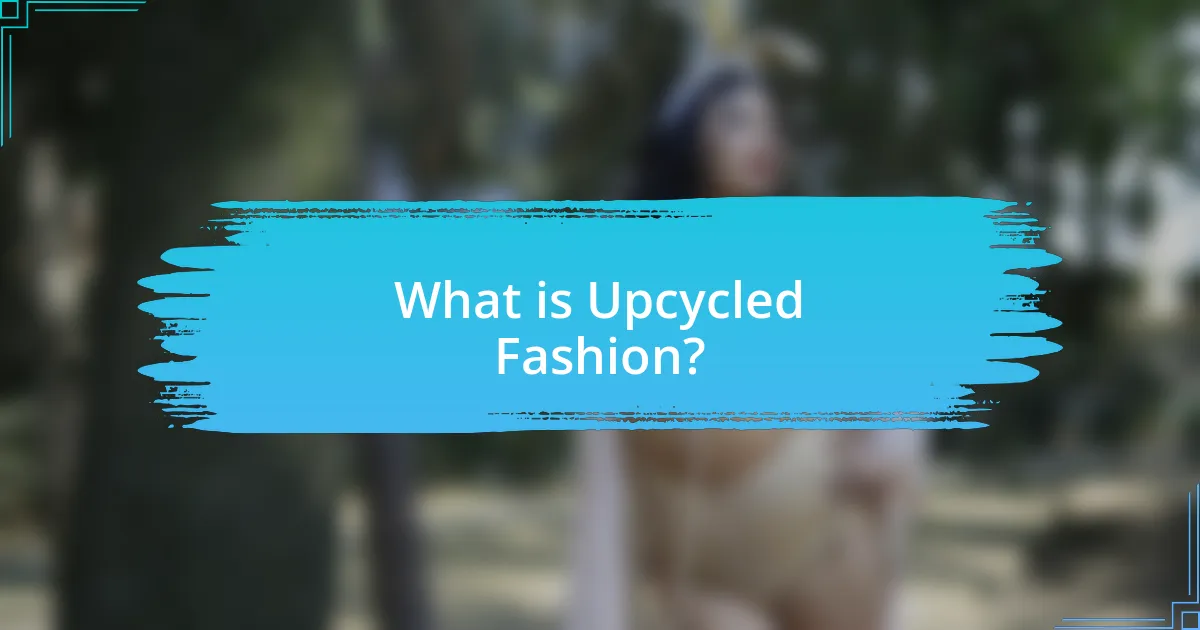
What is Upcycled Fashion?
Upcycled fashion is the practice of repurposing old or discarded clothing and materials into new, fashionable items. This approach not only reduces waste but also promotes sustainability in the fashion industry. According to a report by the Ellen MacArthur Foundation, the fashion industry is responsible for 92 million tons of waste annually, highlighting the importance of upcycling as a solution to mitigate environmental impact.
How does upcycled fashion differ from traditional fashion?
Upcycled fashion differs from traditional fashion primarily in its use of pre-existing materials to create new garments, whereas traditional fashion typically relies on new fabrics and resources. Upcycled fashion emphasizes sustainability by repurposing discarded clothing and textiles, reducing waste and environmental impact, while traditional fashion often contributes to resource depletion and pollution through mass production. For instance, the global fashion industry is responsible for approximately 10% of annual carbon emissions, highlighting the environmental cost of conventional practices. In contrast, upcycled fashion promotes creativity and innovation by transforming old items into unique pieces, fostering a circular economy that values resourcefulness over consumption.
What are the key principles of upcycled fashion?
The key principles of upcycled fashion include sustainability, creativity, and resourcefulness. Sustainability focuses on reducing waste by repurposing materials that would otherwise be discarded, thereby minimizing environmental impact. Creativity involves designing new garments or accessories from old clothing, allowing for unique and personalized fashion statements. Resourcefulness emphasizes the innovative use of available materials, encouraging consumers and designers to think outside the box and find value in what is often considered trash. These principles collectively promote a more eco-friendly approach to fashion, aligning with the growing demand for responsible consumption.
Why is upcycled fashion gaining popularity?
Upcycled fashion is gaining popularity due to increasing consumer awareness of environmental sustainability and the desire for unique, personalized clothing. The fashion industry is one of the largest polluters globally, with the Ellen MacArthur Foundation reporting that the equivalent of one garbage truck of textiles is landfilled or incinerated every second. As a response, consumers are seeking alternatives that reduce waste and promote eco-friendly practices. Additionally, upcycled garments often feature distinctive designs, appealing to individuals who want to express their individuality in a market saturated with mass-produced items. This combination of environmental consciousness and the quest for uniqueness drives the growing trend of upcycled fashion.
What are the environmental impacts of upcycled fashion?
Upcycled fashion significantly reduces environmental impacts by minimizing waste and conserving resources. By repurposing discarded materials, upcycled fashion diverts textiles from landfills, where they can take decades to decompose, thus reducing landfill overflow. Additionally, it decreases the demand for new raw materials, which in turn lowers water usage, energy consumption, and carbon emissions associated with the production of new clothing. For instance, the Ellen MacArthur Foundation reports that the fashion industry is responsible for 10% of global carbon emissions, and upcycling can help mitigate this by extending the lifecycle of existing garments.
How does upcycled fashion contribute to sustainability?
Upcycled fashion contributes to sustainability by reducing waste and minimizing the demand for new resources. By transforming discarded materials into new clothing items, upcycled fashion diverts textiles from landfills, where they can take years to decompose. According to the Environmental Protection Agency, in 2018, 11.3 million tons of textile waste were generated in the United States alone, highlighting the significant impact of textile disposal. Furthermore, upcycling decreases the need for virgin materials, which often require extensive water, energy, and chemical inputs for production. This process not only conserves resources but also lowers carbon emissions associated with manufacturing new garments. Thus, upcycled fashion plays a crucial role in promoting a circular economy and fostering environmental responsibility.
What role does waste reduction play in upcycled fashion?
Waste reduction is a fundamental aspect of upcycled fashion, as it directly addresses the environmental impact of textile waste. By repurposing discarded materials into new garments, upcycled fashion minimizes the volume of waste sent to landfills, which is a significant contributor to pollution and resource depletion. According to the Environmental Protection Agency, in 2018, 11.3 million tons of textile waste were generated in the United States alone, highlighting the urgent need for sustainable practices. Upcycled fashion not only reduces this waste but also promotes a circular economy, where materials are reused and recycled, thereby conserving resources and reducing the demand for new textiles.
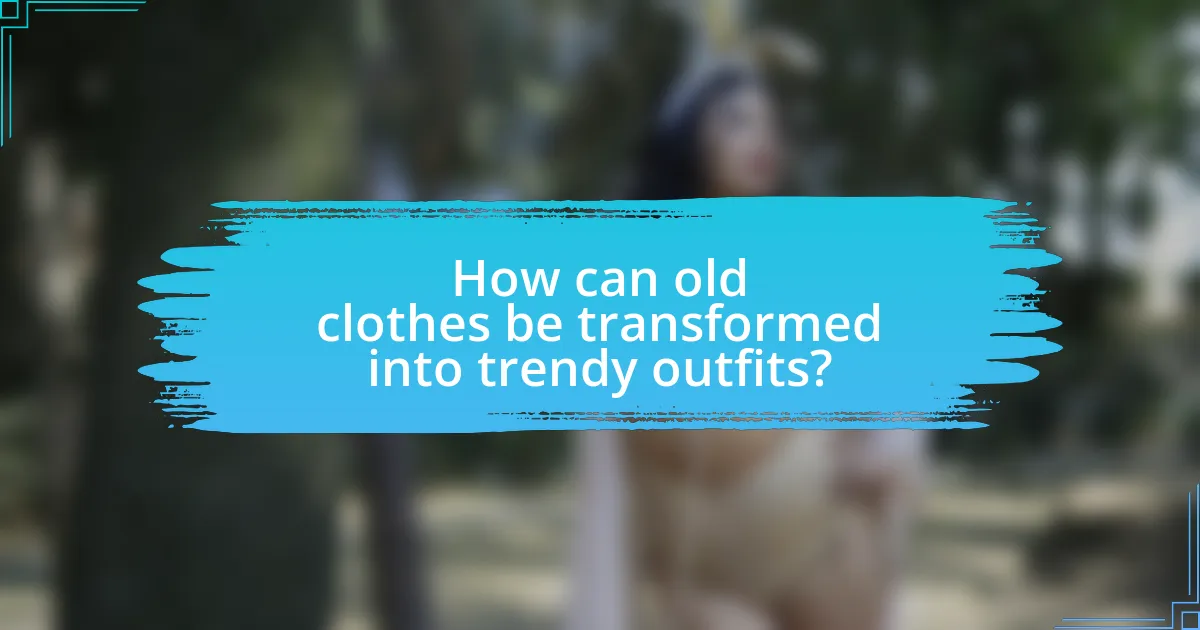
How can old clothes be transformed into trendy outfits?
Old clothes can be transformed into trendy outfits by employing techniques such as upcycling, altering, and accessorizing. Upcycling involves creatively repurposing garments, like turning a long dress into a stylish skirt or adding embellishments to enhance their appeal. Altering clothes can include tailoring for a better fit or dyeing to refresh the color, making them more fashionable. Accessorizing with modern items, such as statement belts or trendy shoes, can also elevate the overall look. According to a report by the Ellen MacArthur Foundation, the global fashion industry could reduce its environmental impact significantly by embracing upcycled fashion, highlighting its growing relevance and trendiness.
What techniques are commonly used in upcycling clothing?
Common techniques used in upcycling clothing include patchwork, dyeing, and reconstruction. Patchwork involves sewing together pieces of fabric from old garments to create new designs, which not only adds visual interest but also utilizes materials that would otherwise be discarded. Dyeing techniques, such as tie-dye or natural dyeing, allow for the transformation of colors and patterns, giving a fresh look to outdated items. Reconstruction entails altering the structure of a garment, such as changing its silhouette or combining elements from multiple pieces, to create a unique and fashionable item. These methods effectively reduce textile waste and promote sustainable fashion practices.
How can sewing and stitching techniques enhance old garments?
Sewing and stitching techniques can enhance old garments by allowing for customization, repair, and the incorporation of modern design elements. These techniques enable individuals to mend damaged areas, thus extending the life of the clothing, while also providing opportunities to add unique embellishments or alterations that reflect current fashion trends. For instance, studies show that upcycling through sewing can increase the perceived value of garments, as consumers appreciate the craftsmanship and individuality that comes with personalized modifications.
What are some creative ways to repurpose fabric?
Creative ways to repurpose fabric include making tote bags, creating patchwork quilts, and designing home decor items like cushion covers. For instance, transforming old t-shirts into tote bags not only reduces waste but also provides a functional item, as studies show that reusable bags can significantly decrease plastic usage. Additionally, patchwork quilts made from various fabric scraps can preserve memories while providing warmth, with the quilting industry reporting a resurgence in interest for handmade items. Lastly, using fabric remnants to create cushion covers can enhance home aesthetics and promote sustainability, aligning with the growing trend of upcycled fashion.
What tools and materials are needed for upcycling?
To upcycle effectively, essential tools and materials include scissors, sewing machines, fabric glue, and various types of old clothing or textiles. Scissors are necessary for cutting fabric, while a sewing machine facilitates stitching pieces together, allowing for more complex designs. Fabric glue serves as an alternative for those who may not sew, providing a quick way to bond materials. Old clothing or textiles serve as the primary raw materials for upcycling, enabling the transformation of discarded items into fashionable pieces. These tools and materials are fundamental for creating unique, sustainable fashion items from pre-existing garments.
Which basic sewing tools should every upcycler have?
Every upcycler should have essential sewing tools including a sewing machine, scissors, pins, measuring tape, and a seam ripper. A sewing machine allows for efficient stitching and alterations, while scissors are crucial for cutting fabric accurately. Pins help hold pieces together during assembly, and measuring tape ensures precise measurements for fitting. A seam ripper is necessary for correcting mistakes and removing stitches. These tools collectively enable effective transformation of old garments into fashionable items, supporting the upcycling process.
What types of materials can be used for upcycling projects?
Upcycling projects can utilize a variety of materials, including textiles, wood, glass, metal, and plastic. Textiles from old clothing can be repurposed into new garments or accessories, while wood from pallets or furniture can be transformed into home decor or functional items. Glass containers can be converted into storage solutions or decorative pieces, metal scraps can be fashioned into art or furniture, and plastic items can be reimagined into useful products. The versatility of these materials supports sustainable practices and creativity in upcycling.

What are some popular trends in upcycled fashion?
Popular trends in upcycled fashion include the use of vintage clothing, patchwork designs, and the incorporation of sustainable materials. Vintage clothing has gained popularity as consumers seek unique pieces with history, reducing the demand for new garments. Patchwork designs, which combine various fabric scraps, not only showcase creativity but also minimize waste by repurposing leftover materials. Additionally, the use of sustainable materials, such as organic cotton and recycled fabrics, aligns with the growing consumer preference for environmentally friendly fashion choices. These trends reflect a shift towards sustainability and individuality in the fashion industry.
How can upcycled fashion be integrated into everyday wear?
Upcycled fashion can be integrated into everyday wear by creatively repurposing old garments into new, stylish pieces. This can involve techniques such as cutting, sewing, or embellishing to transform items like jeans into bags or shirts into dresses. The practice not only promotes sustainability but also allows individuals to express their unique style, as each upcycled piece is often one-of-a-kind. According to a report by the Ellen MacArthur Foundation, the fashion industry is responsible for significant waste, and upcycling helps mitigate this by extending the life cycle of clothing, thereby reducing landfill contributions.
What styles are currently trending in upcycled fashion?
Currently trending styles in upcycled fashion include patchwork designs, vintage-inspired silhouettes, and reimagined streetwear. Patchwork designs utilize various fabric scraps to create unique, colorful garments, reflecting a sustainable approach to fashion. Vintage-inspired silhouettes often incorporate retro elements, appealing to consumers’ nostalgia while promoting eco-friendly practices. Reimagined streetwear combines elements from different clothing items, creating fresh, contemporary looks that resonate with younger audiences. These trends highlight the creativity and resourcefulness inherent in upcycled fashion, as designers and consumers alike seek to reduce waste while expressing individual style.
How can upcycled pieces be styled for different occasions?
Upcycled pieces can be styled for different occasions by mixing them with complementary items to create versatile outfits. For casual outings, pairing an upcycled denim jacket with a simple t-shirt and leggings offers a relaxed look. For formal events, an upcycled dress can be enhanced with elegant accessories like statement jewelry and heels, showcasing creativity while maintaining sophistication. Additionally, upcycled accessories, such as bags or shoes, can elevate any outfit, making them suitable for both everyday wear and special occasions. This adaptability highlights the growing trend of sustainable fashion, where 60% of consumers are willing to pay more for sustainable products, according to a 2021 McKinsey report.
What are some successful examples of upcycled fashion brands?
Successful examples of upcycled fashion brands include Reformation, which transforms vintage clothing into modern styles, and Patagonia, known for its Worn Wear program that repairs and resells used gear. Another notable brand is Eileen Fisher, which has a Renew program that takes back old garments to be remade into new pieces. These brands demonstrate the viability of upcycled fashion by combining sustainability with consumer demand, contributing to a growing market that values eco-friendly practices.
How have these brands influenced the fashion industry?
These brands have significantly influenced the fashion industry by popularizing upcycled fashion, which promotes sustainability and creativity. For instance, brands like Reformation and Patagonia have integrated upcycling into their business models, encouraging consumers to embrace environmentally friendly practices. This shift has led to a broader industry trend where major fashion houses are now incorporating recycled materials into their collections, with a report from McKinsey & Company indicating that the sustainable fashion market is projected to grow by 9.7% annually through 2025. Consequently, these brands have not only changed consumer perceptions but also pressured traditional fashion companies to adopt more sustainable practices.
What can we learn from their business models?
We can learn that upcycled fashion business models prioritize sustainability, creativity, and consumer engagement. These models demonstrate that businesses can effectively reduce waste by transforming discarded materials into fashionable products, appealing to environmentally conscious consumers. For instance, brands like Reformation and Patagonia have successfully integrated eco-friendly practices into their operations, showcasing that profitability can coexist with environmental responsibility. This approach not only attracts a growing market segment focused on sustainability but also fosters brand loyalty through transparency and ethical practices.
What are practical tips for starting with upcycled fashion?
To start with upcycled fashion, begin by gathering old clothing items that you no longer wear. Assess these items for their potential; look for pieces that can be easily altered or combined with other garments. Utilize basic sewing skills to make modifications, such as cutting, stitching, or dyeing, to create unique designs. Research online tutorials or join local workshops to enhance your skills and gain inspiration. According to a report by the Ellen MacArthur Foundation, upcycling can significantly reduce textile waste, making it an environmentally friendly choice.
How can beginners choose the right clothes for upcycling?
Beginners can choose the right clothes for upcycling by selecting items that are made from durable fabrics, such as denim or cotton, which can withstand alterations. Additionally, they should look for clothes with unique features, like interesting patterns or textures, that can be enhanced through creative modifications. Research indicates that upcycling garments made from high-quality materials not only results in better final products but also promotes sustainability by reducing waste.
What are some common mistakes to avoid in upcycling projects?
Common mistakes to avoid in upcycling projects include underestimating the time and effort required, neglecting proper planning, and failing to consider the materials’ condition. Many individuals dive into projects without a clear vision, which can lead to unsatisfactory results. Additionally, using unsuitable tools or techniques can compromise the quality of the final product. Research indicates that successful upcycling often hinges on thorough preparation and skillful execution, emphasizing the importance of these factors in achieving desirable outcomes.
